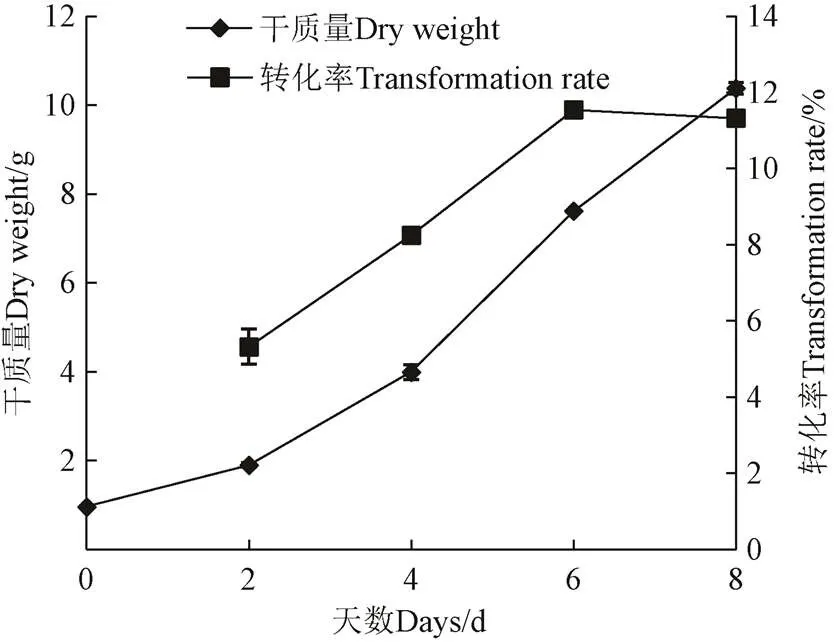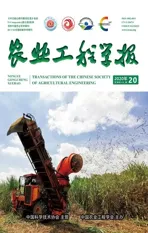黑水虻生物转化猪粪过程中重金属的迁移变化
2020-12-25王小波蔡瑞婕耿维娜毛志月蒋会东徐晓燕
王小波,蔡瑞婕,耿维娜,毛志月,赵 毅,蒋会东,徐晓燕
黑水虻生物转化猪粪过程中重金属的迁移变化
王小波,蔡瑞婕,耿维娜,毛志月,赵 毅,蒋会东,徐晓燕※
(天津农学院农学与资源环境学院,天津 300384)
利用黑水虻处理猪粪为一种高效的环境友好型的技术,但猪粪中重金属的含量对黑水虻的转化产生影响。该研究在30 ℃环境下猪粪中接种7日龄的黑水虻幼虫,研究黑水虻的生长和对猪粪的转化效率,以及猪粪中的重金属(Cu、Zn、Cr、Cd、As)在黑水虻虫体和虫粪中的变化情况。结果表明:在8 d的生长过程中,0~2 d时,生长速率最慢,4~6 d时生长速率最快,在第8天时虫体干质量最高。黑水虻对猪粪的转化率随着时间的延长而增加,在第6天时达到了最大11.5%,而到第8天时下降。在转化过程中虫体中Cu、Cr、As的浓度随着黑水虻幼虫生长降低,在第8天时,虫体Cu、Cr、As浓度较第2天分别降低了24.5%、21.7%、33.1%。Cd含量随着黑水虻幼虫生长增加,在第8天时,虫体Cd浓度较第2天增加了75.3%。Cu、Cr、As、Cd在虫粪中浓度的变化同虫体变化相反。Zn在虫体和虫粪中含量没有发生显著变化。在第8天时虫粪中的Cd含量显著低于猪粪,而Cu、Cr、As、Zn含量与猪粪比没有显著差异。黑水虻幼虫对猪粪中Cd的富集系数最高,达到了3.8,其余都小于1,各重金属的富集顺序从大到小依次为Cd、Zn、Cu、Cr、As。转化后Cu、Cr、As、Zn有83.6%~92.7%分布于虫粪,而Cd有49.8%~69.7%分布于虫粪,30.3%~50.2%分布于虫体。转化后Cu、As的生物活性提高,Cr、Cd的生物活性降低,Zn的生物活性没有明显的变化。研究结果为畜禽粪便的黑水虻生物转化提供参考。
粪;重金属;黑水虻;虫粪;形态
0 引 言
近年来中国畜禽养殖业快速发展,已经成为农业和农村经济发展的支柱产业之一[1]。但大量养殖废弃物未得到及时有效的处理和应用,成为环境治理的一大难题[2]。2016年中国畜禽废弃物年产量约38亿t,其中生猪粪污年产量约18亿t,占到47%,而这些废弃物的综合利用率只有60%[3-4],大量的未利用的养殖废弃物严重影响了周围的大气、土壤、水体和环境卫生[5-6]。为保证畜牧业的健康发展,减少畜禽粪便带来的环境污染等一系列问题,粪便的无害化处理及利用成为了农业环境研究的热点之一[7]。其中能以动物粪便为食的腐生性昆虫在畜禽废弃物处理中得到初步的研究与应用[8-9]。
黑水虻,又名亮斑扁角水虻,腐生性的水虻科昆虫,幼虫主要以腐烂有机物、动物粪便等为食,在取食动物粪便时能够对粪便中的营养物质进行转化并有效减少粪便臭味,降低粪便中的病菌、抗生素等有害物数量[10-11];黑水虻幼虫中含有丰富的蛋白质、脂肪、钙、磷等营养物质,是良好的生物蛋白饲料[12-13]。利用黑水虻幼虫处理畜禽粪便,转化后的产物高蛋白虫体和虫粪有机肥都具有较高的经济价值,既可消除禽畜粪便对环境的污染、实现粪污就近就地利用,同时还能增加养殖收入,为畜禽粪便的处理提供了一种经济、可行的途径,受到了国内外的广泛关注[14-15]。
在畜禽养殖过程中,为了提高饲料利用率,促进畜禽生长发育,降低养殖成本,常在饲料中添加各种重金属微量元素[16-17],但由于畜禽对微量元素的利用率很低,大部分通过粪便排出体外,造成了畜禽粪便中各种重金属元素的含量超标[18-19]。黑水虻处理畜禽粪便的过程中,重金属会在黑水虻体内积累[20],而且前人的研究也发现黑水虻对重金属具有较强的耐受能力[21-22]。但在黑水虻转化处理畜禽粪便过程中黑水虻体内和虫粪中重金属的变化情况还未见报道,本文研究了在黑水虻处理猪粪过程中各种重金属在虫体和虫粪中含量的变化情况。以期为黑水虻转化处理畜禽粪便,及转化产物的资源化利用提供参考。
1 材料与方法
1.1 试验材料
猪粪取自天津市静海区某养殖场,其基础理化指标为有机质含量84.7%,全氮1.79%,P2O52.66%,K2O 1.87%,pH值6.19,电导率10.22 mS/cm,重金属Cu、Zn、Cr、Cd、As含量分别为395.7、408.2、93.1、1.3、2.3 mg/kg。
黑水虻卵取自天津农学院有机废弃物资源化技术研发中心,虫卵在温度(30±2)℃,湿度(80±5)%的环境中,孵化48 h后,转入含水量80%的麦麸中,在温度(30±2) ℃环境中保育7 d后,放入猪粪中进行试验。虫体重金属Cu、Zn、Cr、Cd、As含量分别为21.77、185.53、0.26、0.34、0.01 mg/kg。
1.2 试验设计
在12个培养盒(21 cm ×15. 5 cm ×10 cm)中,分别放入7日龄黑水虻幼虫4 g,在温度(30±2)℃,湿度60%~80%的环境中养殖,每天待猪粪转化完后再加入适量湿度70%猪粪(图1),在第2天、4天、6天、8天猪粪加入前,各取3盒,停止加入猪粪,放置24 h,待虫体完全排出体内残余猪粪后筛分。

图1 黑水虻处理猪粪过程样品的添加与采样
1.3 测定项目与方法
筛分出虫体、虫粪后,虫体微波烘干(功率1 kW,时间5 min)后,称总质量。测虫体重金属含量:称0.500 0 g粉碎后的样品加入8 mL HNO3和2 mL H2O2放入CEM-MARS 6S微波消解,180 ℃,保持15 min,消解后取出消解管,置于智能控温电加热器上140℃赶酸至近干,将管中溶液转移至 50mL 容量瓶中,用去离子水定容,ICP-MS(Thermo)测定重金属含量。
虫粪风干后,称质量,烘干法测含水量。称0.500 0 g风干粉碎后的猪粪、虫粪加入6 mL HNO3、2 mL HCl和2 mL H2O2,微波消解,参数设置同上,赶酸后定容至50 mL,用ICP-MS(Thermo)测定重金属含量。采用BCR修正形态分级法[23]提取猪粪、第8天转化结束后虫粪中各重金属F1弱酸溶解态、F2可还原态、F3可氧化态、F4残渣态,ICP-MS测定。
转化率=虫体干质量增加量/投喂的料干质量(1)
生物富集系数=虫体重金属含量/猪粪重金属含量 (2)
1.4 数据处理
试验数据计算、作图采用Excel2010 软件完成,显著性差异分析采用SPSS 17. 0 Duncan’s 新复极差法(<0.05)完成。
2 结果与分析
2.1 黑水虻虫体生物量和对猪粪转化率的变化
黑水虻虫体干质量随着生长时间的延长而增加(图 2),在第8天时干质量最高,达10.38 g,在0天到2天时,生长速率最慢,在4 天到6 天时生长速率最快。黑水虻对猪粪的转化率随着时间的增加而增加,在第6天时达到了最大11.5%,而到第8天时下降。

图2 黑水虻虫体生物量和对猪粪转化率的变化
2.2 重金属在虫体、虫粪中的变化
猪粪经黑水虻转化过程中,猪粪中的重金属部分转移到黑水虻虫体,使虫体各种金属含量显著提高(表 1)。随着黑水虻幼虫生长,虫体中的重金属浓度也发生变化,且不同重金属的变化规律不同。虫体中Cu、Cr、As的浓度随着黑水虻幼虫的生长而降低,在第8 天时,虫体Cu、Cr、As浓度较第2 天分别降低了24.5%、21.7%、33.1%。虫体Cd的浓度随着黑水虻幼虫的生长而增加,在第8天时,虫体Cd浓度为5.05 mg/kg,较第2天增加了75.3%。而虫体Zn的浓度在黑水虻幼虫第2天到第8天的生长过程中没有显著变化。

表1 虫体与虫粪中重金属的含量
注:同列不同小写字母表示在0.05 水平上差异显著,下同。
Note: Different lower case letters in the same column indicate significant differences at the 0.05 level, same as below.
猪粪经黑水虻转化过程中,猪粪中的重金属部分转移到黑水虻虫粪。随着黑水虻幼虫生长,虫粪中的重金属浓度也发生变化,且不同重金属的变化规律不同(表 1)。虫粪中Cu、Cr、As含量在转化初期第2天,第4天时含量低于原猪粪含量,而随着黑水虻生长虫粪中的Cu、Cr含量增加,到第8天时,同原猪粪含量没有差异。虫粪中Zn含量在黑水虻生长过程中同原猪粪相比没有显著变化。虫粪中Cd含量随着黑水虻的生长而降低,在第8天时,含量最低(0.97 mg/kg),较原猪粪降低了27.1%。
2.3 黑水虻对各重金属的生物富集系数
猪粪经黑水虻转化后,黑水虻对不同重金属有不同的生物富集系数(图3),Cd的富集系数最高,达到了3.8,其次为Zn、富集系数为0.99,Cu、Cr、As的富集系数分别为0.55、0.44、0.43。
2.4 不同重金属在虫体、虫粪的分配比例
猪粪中的重金属经黑水虻转化后,分布于黑水虻虫体和虫粪(表2),其中Cu、Cr、As、Zn主要分布于虫粪,占83.6%~92.7%,而Cd在虫体的分配比例为30.3%~50.2%,在虫粪的分配比例为49.8%~69.7%。在转化过程中随着黑水虻的生长,Cu、Cr、As在虫体的分配比例随着天数的增加而降低,Cu由11.8%降低到9.1%,Cr由11.2%降低到7.4%,As由11.8%降低到7.3%。Cd在虫体的分配比例随着天数的增加而提高,由30.3%增加到50.2%,Zn在虫体(15.2 %~16.4 % )和虫粪(83.6 %~84.8 %)中的分配比例没有随着黑水虻的生长而发生显著变化。

图3 不同重金属的生物富集系数

表2 不同重金属在虫体虫粪的分配比例
2.5 猪粪经黑水虻转化后各重金属形态的变化
猪粪将黑水虻转化后,在虫粪中各重金属的形态发生了变化(表3)。虫粪中Cu的F1含量较原猪粪增加了201.7%,F2、F3含量分别下降了14.5%和22.2%,F4含量没有显著变化。Zn的各形态含量都没有显著变化。Cr的F1、 F2含量分别降低了13.4%和29.8%,F3、 F4含量分别增加了84.2%和117.4%。Cd的F1、 F2、F3含量分别降低了26.5%、33.3%和60.0%,F4含量增加了20.0%。As的F1、 F3、F4含量分别增加了9.0%、29.7%和45.5%,F2含量降低了43.8%。

表3 猪粪、虫粪中重金属各形态含量
注:同一金属同行数字后不同小写字母表示在0.05水平上差异显著。
Note: For the same metal, different lower case letters after peer numbers indicate significant differences at the 0.05 level.
3 讨 论
环境条件对黑水虻转化处理畜禽粪便具有较大的影响[24],在已有研究的基础上,选择最佳环境条件温度30 ℃、湿度80%、猪粪湿度70%进行试验。在此环境条件下,7日龄的黑水虻幼虫经过8 d的生长即将进入预蛹期,为最佳的商品虫收获期。在黑水虻生长过程中,前期因为幼虫的个体小、食量小,虫体质量增加较慢,在中期随着黑水虻幼虫个体的变大,食量增加,虫体质量也增加较快,在试验中第4天到第6天是黑水虻干质量增加最快的时期,同袁橙等[24]的研究结果一致,后期因幼虫即将进入预蛹期,食量下降,虫体质量增加变慢。同时中期也是转化效率最高的时期,在第6天时,黑水虻对猪粪的转化效率最高。
黑水虻对不同金属元素的吸收机制不同,因而对不同的金属元素的富集和耐受规律也不同[21-22],在本试验中黑水虻对猪粪中各种金属的富集顺序为Cd> Zn>Cu>Cr>As。黑水虻幼虫与其他昆虫种类相比具有极高的Ca含量[25],而镉与钙拥有相似的离子半径,可以被热休克蛋白通过钙离子通道进行运输,而不依赖于细胞胞吞作用或需要ATP的离子泵[26-27],造成黑水虻幼虫对镉的高富集(BAF 3.8)。其他的研究也表明昆虫对重金属元素的摄入会提高体内金属硫蛋白的水平,重金属元素与金属硫蛋白结合或螯合在囊泡中,从而有效地使这些金属失活,积累在昆虫体内,在某些情况下,这些物质通过胞吐到消化道内腔排出[28-29],残留于虫粪中,使虫体免收危害,这可能就是黑水虻体内能累积大量镉的原因。
Zn是生物体维持机体正常生理功能和生长发育所必须的微量元素[30],Zn在黑水虻体内分布于中肠、脂肪体、表皮,分布的规律为中肠>脂肪体>表皮[31],对昆虫来说锌是一种重要,但同时具有潜在毒性的元素,昆虫体内的存在的金属结合相应转录因子-1(MTF-1)[32],能够主动调节昆虫对锌的吸收,使锌的BAF随食物中锌浓度变化而变化[20],在家蝇幼虫生物体具有类似的调节机制[33]。本试验中黑水虻对锌的富集系数高于除Cd外的其他元素。Cu主要存在于双翅目昆虫幼虫中肠上皮细胞的细胞浆内[34],As也主要存在于黑水虻于肠道内[21],都会随着黑水虻的生长代谢而排出体外,所以黑水虻对Cu,As的生物富集也较低。在黑水虻幼虫的生长过程中,前期黑水虻幼虫个体小,生长发育慢,对猪粪的转化率也低,造成了重金属Cu、Cr、As在虫体累积的浓度高,后期随着黑水虻幼虫生长代谢加快,对猪粪的转化率也提高,重金属Cu、Cr、As在虫体累积的浓度降低。由于黑水虻对Cd的特殊吸收机制,而且本试验猪粪中Cd的浓度远低于黑水虻对Cd的耐受值[35],所以在黑水虻幼虫生长过程中体内Cd的含量一直在提高。由于黑水虻对Zn的调节吸收,使黑水虻体内Zn的浓度没有发生显著变化。猪粪中的重金属一部分被虫体吸收后,剩余的随虫粪排出体外,所以虫粪中各种重金属浓度的含量变化同虫体相反,虫粪中Cu、Cr、As的浓度随着黑水虻生长增加,第8天时,同原猪粪浓度相比没有显著变化,而虫粪中Cd的含量随着黑水虻的生长而降低,Zn在虫粪中的浓度不随着黑水虻的生长而变化。
猪粪中的重金属转移到黑水虻虫体和虫粪,对黑水虻虫体和虫粪的进一步应用带来的环境风险,对照中国《饲料卫生标准》GB 10378—2017对饲料原料中Cd、Cr、As的限值标准,虫体中的Cd、Cr含量超出限值,在应用时应注意配比,使在饲料标准的安全范围内。对照中国有机肥标准NY/T 3442—2019,猪粪和虫粪中的重金属含量都在安全限值之内,对照欧盟堆肥生态标准[36]原猪粪中Cu、Zn、Cd超出了限值,经黑水虻转化后虫粪中Cd含量降低到安全限值以下。
有机肥中的重金属对作物生长的影响除与重金属的总量有关外,还与重金属的存在形态有关,重金属的形态直接影响重金属的毒性、迁移及其在自然界中的循环[37]。本研究采用BCR法将猪粪、虫粪中的各种重金属分为弱酸溶解态、可还原态、可氧化态、残渣态。其中弱酸溶解态最容易被吸收,生物活性最大,从试验结果可见猪粪经黑水虻转化后,在虫粪中Cu、As的生物活性提高,Cr、Cd的生物活性降低,Zn没有发现明显的变化。张文娟[38]对蝇蛆转化猪粪的研究结论表明Cu、Zn的生物活性提高,Cr、Cd的生物活性降低,与本研究结果较一致,但Zn的变化存在差异,可能与黑水虻和蝇蛆的生理代谢不同有关。
4 结 论
利用黑水虻幼虫处理猪粪,可以实现对猪粪的高值高效资源化利用,解决猪粪的环境污染问题。在转化过程中虫体中Cu、Cr、As的浓度随着黑水虻幼虫生长降低,Cd含量随着黑水虻幼虫生长增加,在虫粪中正好相反。Zn在虫体和虫粪中含量没有随黑水虻幼虫的生长发生显著变化。转化结束后猪粪中的重金属大部分累积于黑水虻虫粪中(49.8%~92.7%)。黑水虻虫体对猪粪中各重金属的富集从大到小依次为Cd、Zn、Cu、Cr、As。经转化后猪粪中Cu、As的生物活性提高,Cr、Cd的生物活性降低,Zn没有发生明显的变化。
[1] 王明利. 改革开放四十年我国畜牧业发展:成就、经验及未来趋势[J]. 农业经济问题,2018(8):60-70. Wang Mingli. China's livestock industry development: Achievements, experiences and future trends[J]. Issues in Agricultural Economy, 2018(8): 60-70. (in Chinese with English abstract)
[2] 田慎重,郭洪海,姚利,等. 中国种养业废弃物肥料化利用发展分析[J]. 农业工程学报,2018,34(增刊1):123-131. Tian Shenzhong, Guo Honghai, Yao Li, et al. Development analysis for fertilizer utilization of agricultural planting and animal wastes in China[J]. Transactions of the Chinese Society of Agricultural Engineering (Transactions of the CSAE), 2018, 34(Supp.1): 123-131. (in Chinese with English abstract)
[3] 中国畜牧兽医年鉴编辑委员会. 中国畜牧兽医年鉴2017[M]. 北京:中国农业出版社,2017.
[4] 农业部. 全国每年 38 亿吨畜禽废弃物综合利用率只有6成[J]. 家禽科学,2018(3):5.
[5] Martinez J, Dabert P, Barrington S, et al. Livestock waste treatment systems for environmental quality, food safety, and sustainability[J]. Bioresource Technology, 2009, 100(22): 5527- 5536.
[6] Juma M, Sardar K, Jian Q, et al. Antibiotics in poultry manure and their associated health issues: A systematic review[J]. Journal of Soils and Sediments, 2020, 20: 486-497.
[7] 孙敬都,罗印林,王可心,等. 畜禽粪便无害化处理技术研究进展[J]. 今日畜牧兽医,2019,35(1):63-65.
[8] Kashifur R, Minmin C, Xiao Xiaopeng, et al. Cellulose decomposition and larval biomass production from the co-digestion of dairy manure and chicken manure by mini-livestock ()[J]. Journal of Environmental Management, 2017, 196: 458-465.
[9] Zhu Fengxiang, Yao Yanlai, Wang Sujuan, et al. Housefly maggot-treated composting as sustainable option for pig manure management[J]. Waste Management, 2015, 35: 62-67.
[10] Minmin C, Ma Shiteng, Hu Ruiqi, et al. Rapidly mitigating antibiotic resistant risks in chicken manure by Hermetiaillucens bioconversion with intestinal microflora[J]. Environmental Microbiology, 2018, 20(11): 4051-4062.
[11] 梅瀚杰,胡文锋. 黑水虻对有害物质的降解作用研究进展[J]. 饲料工业,2019,40(20):59-64. Mei Hanjie, Hu Wenfeng. A review of degradation of harmful substance by black soldier fly[J]. Feed Industry, 2019, 40(20): 59-64. (in Chinese with English abstract)
[12] 喻国辉,陈燕红,喻子牛,等. 黑水虻幼虫和预蛹的饲料价值研究进展[J]. 昆虫知识,2009,46(1):41-45. Yu Guohui, Chen Yanhong, Yu Ziniu, et al. Research progression on the larvae and prepupae of black soldier fly Hermetia illucens used as animal feedstuff[J]. Chinese Bulletin of Entomology, 2009, 46(1): 41-45. (in Chinese with English abstract)
[13] Wang Shengyin, Wu Lingli, Li Baoling, et al. Reproductive potential and nutritional composition of Hermetia illucens (Diptera: Stratiomyidae) prepupae reared on different organic wastes[J]. Journal of Economic Entomology, 2020, 113(1): 527-537.
[14] Stefan Diener, Nandayure M. Studt Solano, Floria Roa Gutiérrez, et al. Biological treatment of municipal organic waste using black soldier fly Larvae[J]. Waste Biomass Valor, 2011, 2: 357-363.
[15] Kashifur Rehman, Cai Minmin, Xiao Xiaopeng, et al. Cellulose decomposition and larval biomass production from the co-digestion of dairy manure and chicken manure by mini-livestock()[J]. Journal of Environmental Management, 2017, 196:458-465.
[16] 黄玉溢,陈桂芬,刘斌,等. 广西集约化养殖猪饲料Cu和Zn含量及粪便Cu和Zn残留特性研究[J]. 安徽农业科学,2012,40(17):9280-9281,9284. Huang Yuyi, Chen Guifen, Liu Bin, et al. Content of Cu and Zn in pig feeds and their residual character in pig manures from intensive piggery in Guangxi[J]. Journal of Anhui Agricultural Sciences, 2012, 40(17): 9280-9281, 9284. (in Chinese with English abstract)
[17] 吴大伟,李亚学,吴萍,等. 规模化猪场育肥猪饲料、猪肉及粪便中重金属含量调查[J]. 畜牧与兽医,2012,44(4):38-40. Wu Dawei, Li Yaxue, Wu Ping, et al. Investigation on heavy metals in feed, pork and feces of fattening pigs in large scale pig farm[J]. Animal Husbandry & Veterinary Medicine, 2012, 44(4): 38-40. (in Chinese with English abstract)
[18] Hashe M I, Maj I D. Heavy metal concentrations in bovine tissues (muscle, liver and kidney) and their relationship with heavy metal contentsin consumed feed[J]. Ecotoxicology and Environmental Safety, 2018, 154(10): 263-267.
[19] 潘寻,韩哲,贲伟伟. 山东省规模化猪场猪粪及配合饲料中重金属含量研究[J]. 农业环境科学学报,2013,32(1):160-165. Pan Xun, Han Zhe, Ben Weiwei. Heavy metal contents in pig manure and pig feeds from Intensive pig farms in Shandong Province, China[J]. Journal of Agro-Environment Science, 2013, 32(1): 160-165。(in Chinese with English abstract)
[20] Diener S, Zurbruegg C, Tockner K. Bioaccumulation of heavy metals in the black soldier fly, Hermetia illucens and effects on its life cycle[J]. Journal of Insects as Food and Feed, 2015, 1(4): 261-270.
[21] Vander Fels-Klerx H J, Camenzuli L, van der Lee M K, et al. Uptake of cadmium, lead and arsenic by Tenebrio molitor and Hermetia illucens from contaminated substrates[J]. Plos One, 2016, 11(11): 166-186.
[22] Biancarosa I, Liland N S, Biemans D, et al. Uptake of heavy metals and arsenic in black soldier fly (Hermetia illucens) larvae grown on seaweed-enriched media[J]. Journal of the Science of Food and Agriculture, 2018, 98(6): 2176-2183.
[23] Cai Minmin, Hu Ruiqi, Zhang Ke, et al. Resistance of black soldier fly (Diptera: Stratiomyidae) larvae to combined heavy metals and potential application in municipal sewage sludge treatment[J]. Environmental Science and Pollution Research international, 2018, 25(2): 1559-1567.
[24] 袁橙,魏冬霞,解慧梅,等. 黑水虻幼虫处理规模化猪场粪污的试验研究[J]. 畜牧与兽医,2019,51(11):49-53. Yuan Cheng, Wei Dongxia, Xie Huimei, et al. Research on treatment of fecal pollution on large scale pig farms with black soldier fly larva[J]. Animal Husbandry & Veterinary Medicine, 2019, 51(11): 49-53. (in Chinese with English abstract)
[25] Finke M D, Oonincx D G A B. Insects as Food for Insectivores[M]//Mass Production of Beneficial Organisms, Academic Press,2014: 583-616.
[26] Braeckman B, Smagghe G, Brutsaert N, et al. Cadmium uptake and defense mechanism in insect cells[J]. Environmental Research, 1999, 80: 231-243.
[27] Craig A, Hare L, Tessier A. Experimental evidence for cadmiumuptake via calcium channels in the aquatic insect Chironomusstaegeri[J]. Aquatic Toxicology, 1999, 44(4): 255-262.
[28] Postma J F, Vannugteren P, Marion B. Buckert‐ De Jong. Increased cadmium excretion in metal‐adapted populations of the midge Chironomus riparius (diptera)[J]. Environmental Toxicology and Chemistry, 2010, 15(3): 332-339.
[29] Mireji P O, Keating J, Hassanali A, et al. Expression of metallothionein and alpha- tubulin in heavy metal- tolerant Anopheles gambiae sensu stricto (Diptera: Culicidae)[J]. Ecotoxicology and Environmental Safety, 2010, 73(1): 46-50.
[30] 刘西萍,隋美霞,徐中相,等. 微量元素锌及不同锌源在畜禽营养上的研究进展[J]. 中国畜牧兽医,2014,41(6):94-98. Liu Xiping, Sui Meixia, Xu Zhongxiang, et al. Research progress on zinc and different sources of zinc in animal nutrition[J]. China Animal Husbandry & Veterinary Medicine, 2014, 41(6): 94-98. (in Chinese with English abstract)
[31] 夏嫱,廖业,朱伟,等. Zn2+在不同世代黑水虻体内累积及分布规律[J]. 湖南科技大学学报:自然科学版,2013,28(2):110-114. Xia Qiang, Liao Ye, Zhu Wei, et al. Accumulation and distribution of heavy metal Zn2+in two successive generations black soldier fly Hermetia illucens L. (Dipetra: Stratiomyidae)[J]. Journal of Hunan University of Science & Technology (Natural Science Edition), 2013, 28(2): 110-114. (in Chinese with English abstract)
[32] Laity J H, Andrews G K. Understanding the mechanisms of zinc-sensing by metal-response element binding transcription factor-1 (MTF-1)[J]. Archives of Biochemistry and Biophysics, 2007, 463: 201-210.
[33] Maryanski M, Kramarz P, Laskowski R, et al, Decreased energetic reserves, morphological changes and accumulation of metals in carabid beetles (Poecilus cupreus L. ) exposed to zinc- or cadmium-contaminated food[J]. Ecotoxicology, 2002, 11: 127-139.
[34] Adam S, Asley F, Melanie N, et al. Malvolio is copper transporter in Drosophila melanogaster[J]. The Journal of Experimental Biology, 2008, 211(5): 709-716.
[35] Gao Qiao, Wang Xiaoyun, Wang Wanqiang, et al. Influences of chromium and cadmium on the development of black soldier fly larvae[J]. Environmental Science & Pollution Research, 2017, 24(9): 8637-8644.
[36] Saveyn H, Eder P. End-of-waste Criteria for Biodegradable Waste Subjected to Biological Treatment(Compost & Digest): Technical Proposals[M]. Luxemboury: Publications Office of the European Union, 2014,
[37] 林汲, 程琛, 韩明强, 等.硅藻土有机肥对Cd-Zn复合污染土壤重金属形态和有效性的影响[J]. 农业资源与环境学报, 2014, 31(4):366-371. Lin Ji, Cheng Chen, Han Mingqiang, et al. Effects of diatomite or ganic fertilizer on Cd and Zn forms and availability of Cd-Zn polluted soil[J]. Journal of Agricultural Resources and Environment, 2014, 31(4):366-371. (in Chinese with English abstract)
[38] 张文娟. 重金属在猪粪—蝇蛆—肉鸡食物链上的转移和积累[D]. 武汉:华中农业大学,2016. Zhang Wenjuan. Mobility and Bioaccumulation of Heavy Metal along Manure-Maggot-Broiler Food Chain[D]. Wuhan: Huazhong Agricultural University, 2016. (in Chinese with English abstract)
Migration and changes of heavy metals during biotransformation of pig manure by black soldier fly
Wang Xiaobo, Cai Ruijie, Geng Weina, Mao Zhiyue, Zhao Yi, Jiang Huidong, Xu Xiaoyan※
(,,300384,)
A large amount of livestock manure has caused seriously ecological pollution, as the rapid development of livestock and poultry industry. The black soldier fly larvae (BSFL) are a good candidate for poultry and livestock manure treatment. The harvested insect bodies and feces can also be used as animal feed and organic fertilizer. The usage of BSFL can be efficient and environment-friendly to treat pig manure, but the heavy metals in pig manure have posed a great impact on the BSFL transformation process. In this study, the 7-day-old BSFL were used to transform pig manure at 30℃, in order to explore the BSFL growth and the transformation efficiency of manure, as well as the changes of heavy metals (Cu, Zn, Cr, Cd, As) in the BSFL bodies and feces. After 8 days of transformation, the larvae were about to enter the prepupal stage, where the transformation process terminated. The results showed that the dry weight of BSFL bodies increased with the prolongation of growth time during 8 days, and reached the highest value on the 8th day. The growth rate was the lowest from 0 to 2 d, whereas, the highest from 4 to 6 days. The conversion rate of pig manure increased with time, where the maximum value of 11.5% on the 6th day, and then decreased on the 8th day. The concentrations of Cu, Cr and As in BSFL bodies on the 8th day decreased by 24.5%, 21.7% and 33.0%, respectively, compared with those on the 2th day, indicating an obvious decrease in the concentrations of heavy metals with the larval growth. The content of Cd in BSFL increased with the larval growth, and the Cd concentration on the 8th day increased by 75.4%, compared with that on the 2th day. The changes of Cu, Cr, As and Cd concentrations in the BSFL feces were opposite to those of the bodies. The contents of Zn in the BSFL bodies and feces did not change significantly with the larval growth time. After 8 days of transformation, the Cd content in BSFL feces was significantly lower than that in pig manure, while, the contents of Cu, Cr, As and Zn were not significantly different from those in pig manure. The bioaccumulation factor of Cd by BSFL was the highest (reaching 3.8), and the values of other metals were lower than 1. The bioaccumulation of heavy metals was ranked in order Cd > Zn > Cu > Cr > As. After transformation, the heavy metals Cu, Cr, As and Zn in pig manure were mainly distributed in BSFL feces, accounting for 83.6%-92.7%; whereas, the distribution of Cd was 30.3%-50.2% in BSFL bodies and 49.8%-69.7% in feces. Compared with pig manure, the biological activities of Cu and As in BSFL feces increased, while those of Cr and Cd decreased. The biological activity of Zn did not change significantly after the transformation process. This finding can provide a potential data basis for the resource utilization of livestock manure by BSFL and the safety of transformed products.
manure; heavy metal; black soldier fly; insect feces; speciation
王小波,蔡瑞婕,耿维娜,等. 黑水虻生物转化猪粪过程中重金属的迁移变化[J]. 农业工程学报,2020,36(20):263-268.doi:10.11975/j.issn.1002-6819.2020.20.031 http://www.tcsae.org
Wang Xiaobo, Cai Ruijie, Geng Weina, et al. Migration and changes of heavy metals during biotransformation of pig manure by black soldier fly[J]. Transactions of the Chinese Society of Agricultural Engineering (Transactions of the CSAE), 2020, 36(20): 263-268. (in Chinese with English abstract) doi:10.11975/j.issn.1002-6819.2020.20.031 http://www.tcsae.org
2020-07-24
2020-10-07
国家重点研发项目(2018YFD0500205);天津市科技计划项目(19ZYYFSN00010;18ZXYENC00130)
王小波,高级实验师。主要从事农业废弃物资源化利用与土壤环境研究。Email:wangxiaobo1111@163.com
徐晓燕,博士,教授,主要从事资源环境科学研究。Email:xuxy6699@163.com
10.11975/j.issn.1002-6819.2020.20.031
X713
A
1002-6819(2020)-20-0263-06
